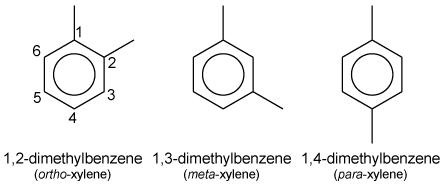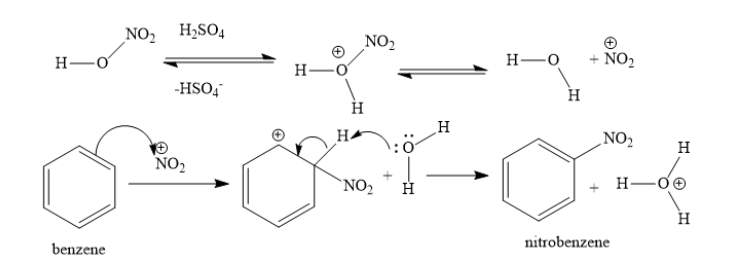Question-1 (a) :2019-may-Chemistry_paper_2__TZ1_HL
Topic:
Xylene is a derivative of benzene. One isomer is 1,4-dimethylbenzene.

Discuss: the number of ${ }^1 \mathrm{H}$ NMR signals for this isomer of xylene and the ratio in which they appear.
Number of signals:
Ratio:
▶️Answer/Explanation
Solution:
$
\begin{aligned}
&\text{In benzene ring}=1 \text { signal } \\
& -\mathrm{CH}_3=1 \text { signal } \\
\end{aligned}
$
$\rightarrow$ gives 2 different signals overall
There are 2 types of hydrogen atoms present in the given isomer of xylene, and thus there will be 2 signals in the ${ }^1 \mathrm{H}$ NMR spectrum.
The ratio of the signals depends on the number of hydrogen atoms associated with each type of carbon atom. In the given isomer, there are two types of carbon atoms: those that are directly attached to one methyl group, and those that are directly attached to two methyl groups. The former has two hydrogen atoms attached, while the latter has only one hydrogen atom attached.
Therefore, the two hydrogen atoms attached to the first type of carbon atom will give a singlet signal, while the hydrogen atoms attached to the second type of carbon atom will give a doublet signal.
The ratio of the singlet to doublet signals will be 6:4, or 3:2, because there are 6 hydrogen atoms attached to the first type of carbon atom and 4 hydrogen atoms attached to the second type of carbon atom.
Question-1(b) :2019-may-Chemistry_paper_2__TZ1_HL
Topic:
Draw: the structure of one other isomer of xylene which retains the benzene ring.
▶️Answer/Explanation
Solution:

The three isomers of xylene are ortho-xylene (1,2-dimethylbenzene), meta-xylene (1,3-dimethylbenzene), and para-xylene (1,4-dimethylbenzene). They differ in the positions of the two methyl groups on the benzene ring.
Question-1[(c) (i)] :2019-may-Chemistry_paper_2__TZ1_HL
Topic:
Given: Xylene, like benzene, can be nitrated.
Write: the equation for the production of the active nitrating agent from concentrated sulfuric and nitric acids.
▶️Answer/Explanation
Solution:
The production of the nitronium ion, which is the active nitrating agent used to nitrate xylene, can be represented by the following equation:
$2 \mathrm{H}_2 \mathrm{SO}_4+\mathrm{HNO}_3 \rightleftharpoons \mathrm{NO}_2^{+}+2 \mathrm{HSO}_4^{-}+\mathrm{H}_3 \mathrm{O}^{+}$
In this reaction, concentrated nitric acid reacts with concentrated sulfuric acid to form the nitronium ion $(\mathrm{NO_2^+})$, which is an electrophile that can attack the aromatic ring of xylene. The sulfuric acid serves as a dehydrating agent, removing water from the nitric acid to form the nitronium ion.
Question-1[(c) (ii)] :2019-may-Chemistry_paper_2__TZ1_HL
Topic:
Explain: the mechanism for the nitration of benzene, using curly arrows to indicate the movement of electron pairs.
▶️Answer/Explanation
Solution:
Benzene reacts with nitric acid and sulphuric acid to form nitrobenzene. It is an example of electrophilic aromatic substitution reaction. One hydrogen atom of benzene ring is replaced with nitro group. Nitric acid reacts with sulphuric acid to form nitronium ions.
The pi electrons of benzene are donated to nitronium ions. A carbon-nitrogen bond is formed and the neighboring carbon atom gains unit positive charge. In this step, the aromaticity of the ring is broken. In the next step, this intermediate loses a proton to the water molecule. In this step, the aromaticity of the ring is regenerated.
Question-1[(d) (i)] :2019-may-Chemistry_paper_2__TZ1_HL
Topic:
Given: Bromine reacts with alkanes.
Discuss: the initiation step of the reaction and its conditions.
▶️Answer/Explanation
Solution:
The initiation step of the reaction between bromine and alkanes involves the homolytic cleavage (or homolysis) of the bromine molecule into two bromine radicals, each carrying one unpaired electron. This is typically achieved by providing energy to the system in the form of heat or light.
The equation for the initiation step can be represented as:
$\operatorname{Br}_ 2(\mathrm{~g}) \rightarrow 2 \mathrm{Br}\boldsymbol{\cdot}(\mathrm{g})$
The conditions for the initiation step depend on the specific alkane and reaction conditions being used. In general, the energy required for homolytic cleavage of the bromine molecule is provided by heat or light, and the reaction is typically carried out in the gas phase or in a non-polar solvent. The initiation step is usually the slowest step in the reaction, and its rate is dependent on the concentration of the reactants and the intensity of the energy source used to initiate the reaction.
